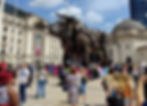A Load of Bull. How Birmingham chose its city symbol
- Al
- Jun 23, 2023
- 3 min read

Birmingham’s famous star of the Commonwealth games opening ceremony is about to take up his new home in the city’s New Street train station. And the popular Raging Bull has a name at last - Ozzy. He may quickly become the city’s most famous bovine ambassador but he’s not the only one.
So why does Birmingham adopt the symbol of a bull? There’s nothing official about it, unlike Manchester’s bee for example, incorporated into the city's coat of arms to represent the characteristic of industry. Animals make great mascots and symbols but Birmingham’s coat of arms doesn’t offer any for use. Arguably, the bull has become a symbol in a more organic way in capturing local imagination and speaking in some way to the city’s spirit.
No doubt it helps that animal and city share the same first letter and it makes for some punchy sports team names - the Birmingham Bulls is the name for both an American Football team and inclusive rugby club based in the city. But it’s surely the Bull Ring that’s given the city this unusual champion.
The area around Birmingham's current Bullring shopping centre, has been known as the Bull Ring, at least informally, since the 16th century, when permission was granted to bait bulls on a green close to St Martin’s church. The bulls were tethered to a ring secured in the ground, before being baited by dogs. Supposedly this tenderized the meat and it was popular for viewers to place bets on the spectacle. A really quite cruel and unpleasant origin behind one of the most famous locations in the city. It seems this local name for the area stuck before later becoming more formally adopted.
The shopping centre built in the area in the 1960s was called the Bull Ring reflecting the historic naming of the area. The development that replaced it in 2003 stylised this as Bullring.

The new centre included a bronze bull which really started to capture the city’s imagination. Officially called The Guardian and created by Laurence Broderick, Brummies have taken him to their hearts and tourists love getting their pictures with him. The centre dress him up for special events - this bull is not so scary when you’ve seen him in his fabulous outfits for events like Pride, St Patrick’s Day and at Christmas. He's also provided the city with a new place to meet - no longer are The Ramp or Pigeon Park the only options.

Last year’s Commonwealth Games built on this popular symbol, first unveiling Perry the bull, the child friendly mascot for the Games. Perry is named after Perry Barr where the main stadium was sited. If you saw him at any events he was often the star of the show! But then came the truly surprising and impressive Raging Bull of Iqbal Khan’s opening ceremony.
This was a more nuanced symbol in acknowledging some of the human costs of industrial growth in the West Midlands. But it linked the bull symbolically with the industrial revolution for the first time. As the growth of the city is so closely linked to industry and innovation, it makes this version of the city's favourite animal a potent representation of civic identity. His new home at the heart of the city in its main train station, is surely going to make Ozzy a popular attraction. He was adored last summer as he entertained visitors in Centenary Square and I hope he can do the same at New Street (and not just block us all from reaching our trains on time).

And my favourite Birmingham bull? The one on Price Street where you can get a great pint and some hearty grub and the only raging you need to worry about is the hangover if you spend a little too long there.